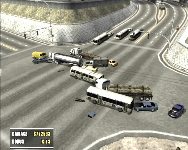I have been playing a Guitar Hero II lately, and I enjoy it immensely.
And yet, there is something disconcerting about the relation between the “frets” (the colored buttons) and the notes that are actually played. On an actual instrument, frets or keys really do correspond to specific notes being played – hitting the A string with your finger on the 3rd fret will consistently play a C. In Guitar Hero the relation is, well, inconsistent.
It looks like we can divide music and rhythm games into those that involve actual playing and those that are about performing.
In Donkey Konga (which I love), Taiko no Tatsujin, or Singstar, the activity of the player is consistently translated into specific sounds that are part of the music. Dance Dance Revolution, on the other hand, is about performing a choreographed sequence along with the music.
And this is where Guitar Hero II fits as well – you don’t play the music, but you perform a choreographed sequence. Performing this sequence just makes the music play correctly.
Guitar Hero‘s emphasis on performing cool/daft rock clichés does go very well with the performance aspect of the gameplay. And the emphasis on style is what Guitar Hero really adds to GuitarFreaks.
*
While music and rhythm games are popular, there is also a fear of music[al notation] running through them – all of them eschew common musical notation in favor of something homemade.
In Singstar, why is there no option to make the game display the tune with proper musical notation instead of the colored rectangles?
And worse, in Guitar Hero, why isn’t there an indicator for triplets? (Triplets: Think about the intro in Killing in the Name). As it is, you have to read ahead and divine from sub-pixel positions of the indicators that the note sequence coming up is actually a triplet. A triplet sign would be nice.

*
I can’t play by ear, but on occasion I have a flash of insight where I realize how to play part of some tune on the piano. That is always very strong – the experience of pressing keys not because they are choreographed, but because I can feel that these keys are the tune. Playing from notes is mostly a combination of those two experiences, following a choreography from the sheet, and pressing keys because those keys are the tune.
Is there something inherent in the music/rhythm genre that makes it hard to make a popular game that really could be played by ear? Singstar can be played by ear, but one with an instrument?


